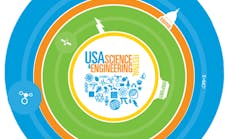This is how William Least Heat Moon defined curiosity in his book, Blue Highways: “Curious, related to cure, means ‘carefully observant.’” It is applicable to engineers, as we tend to be curious and carefully observe the world around us. I thought about this before I left for the USA Science & Engineering Festival. By taking advantage of kids’ natural tendency to be curious, we can teach a generation to be “carefully observant” about patterns in our world and science, technology, engineering, and math (STEM). In doing so, we can improve the likelihood of new discoveries and inventions.
We could all use a little more curiosity. More people seem to be asking what is happening to jobs and industry in the United States. As of January 2015, the U.S. as a nation ranked 27th in math and 20th in science, according to a Pew Research Center study on education. How are we going to stay on the cutting edge while our education is not keeping up with the rest of the world? In order to fix a problem, we must first admit we have one. Second, we must ask, what are we going to do about it?
The approach of today’s U.S. education system increasingly revolves around tests, which can intimidate students and might not teach them the importance of what they are learning. But what we really need are people who are curious, who are free to explore, tinker, and not afraid to fail. “Curiosity is what drives technology and keeps people on the cutting edge,” says Matteo Dariol, product support engineer for Bosch Rexroth. Instilling curiosity about the “guts and gears” of the world at an early age is the best way to make kids curious about STEM, rather than instilling a fear of “wrong answers” on tests that will lead to insufficient grades.
Neil deGrasse Tyson says that no matter what you want to be, scientist or artist, being scientifically literate will help make you better at it. If we fail to spark curiosity, future generations will never understand the benefits of being scientifically literate. Our youth should know calculus. Perhaps, more importantly, they need to understand that it’s not about when they will use it in real life, but engaging the brain in that problem-solving process. Scientific literacy is about knowing how to use the “prime mover” of tools—the brain.
Please let me know any organizations you are a part of that help inspire scientific literacy. In addition, what do you think about the current state of STEM in the USA? What, if anything, should be done to help inspire STEM in the next generation? Email me at [email protected].
Looking for parts? Go to SourceESB.


